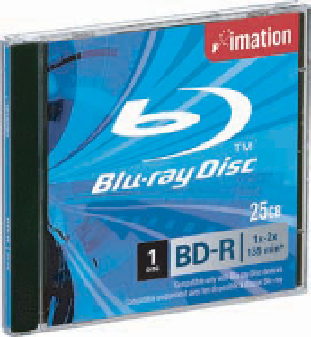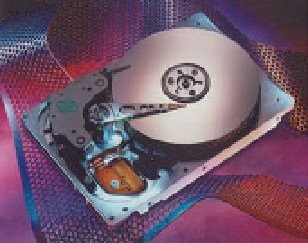Information Technology Reference
In-Depth Information
Devices
The most common forms of secondary storage include magnetic tapes, magnetic disks,
virtual tapes, and optical discs. In general, magnetic tapes are the oldest storage medium,
while optical discs are the most recent. Some of these media (magnetic tape) allow only
sequential access, while others (magnetic and optical discs) provide direct and sequential
access. Figure 3.5 shows one type of secondary storage media.
Figure 3.5
Secondary Storage
Secondary storage devices such as
magnetic tapes and disks, optical
discs, CD-ROMs, and DVDs are used
to store data for easy retrieval at a
later date.
(Source: Courtesy of Imation Corp.)
Magnetic Tape
Magnetic tape
is a type of sequential secondary storage medium, now used primarily for
storing backups. Similar to the tape found in audio- and videocassettes, magnetic tape is a
Mylar film coated with iron oxide. Portions of the tape are magnetized to represent bits. If
the computer needs to read data from the middle of a reel of tape, it must first pass all the
tape before the desired piece of data—one disadvantage of magnetic tape. When information
is needed, it can take time to retrieve the proper tape and mount it on the tape reader to get
the relevant data into the computer. Despite the falling prices of hard drives, tape storage is
still a popular choice for low-cost data backup for off-site storage in the event of a disaster.
Not surprisingly, the U.S. federal government is the largest user of magnetic tape in the world,
buying over 1 million reels of tape each year for use by such organizations as the Internal
Revenue Service, National Oceanic and Atmospheric Administration, the Federal Reserve
Bank, and the various branches of the military.
25
Technology is improving to provide tape storage devices with greater capacities and faster
transfer speeds. In addition, the bulky tape drives used to read and write on large reels of
tapes in the early days of computing have been replaced with tape cartridge devices measuring
a few millimeters in diameter, requiring much less floor space and allowing hundreds of tapes
to be stored in a small area.
magnetic tape
A secondary storage medium; Mylar
film coated with iron oxide with
portions of the tape magnetized to
represent bits.
Magnetic Disks
Magnetic disks
are also coated with iron oxide; they can be thin metallic platters (hard disks,
see Figure 3.6) or Mylar film (diskettes). As with magnetic tape, magnetic disks represent
bits using small magnetized areas. When reading from or writing to a disk, the disk's read/
write head can go directly to the desired piece of data. Thus, the disk is a direct-access storage
medium. Because direct access allows fast data retrieval,
this type of storage is ideal for companies that need to
respond quickly to customer requests, such as airlines and
credit card firms. For example, if a manager needs infor-
mation on the credit history of a customer or the seat
availability on a particular flight, the information can be
obtained in seconds if the data is stored on a direct access
storage device.
Magnetic disk storage varies widely in capacity and
portability. Removable magnetic disks, such as diskettes
or Zip disks, are nearly obsolete. Hard disks, though
magnetic disk
A common secondary storage
medium, with bits represented by
magnetized areas.
Figure 3.6
Hard Disk
Hard disks provide direct access to
stored data. The read/write head
can move directly to the location of
a desired piece of data, dramatically
reducing access times as compared
with magnetic tape.
(Source: Courtesy of Seagate Tech-
nology.)






